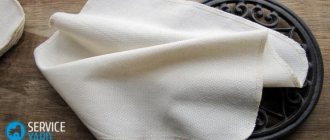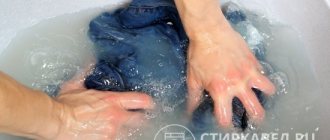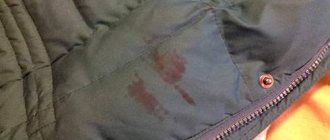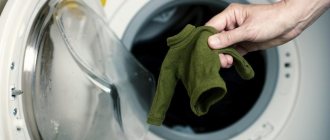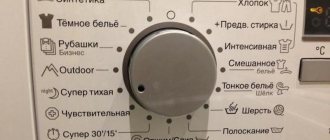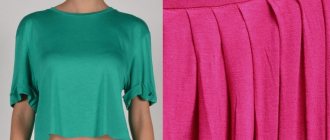Clothes made from artificial fabrics are quite durable and attractive; in hot weather it is not practical to wear products made from such fibers. They do not allow the skin to breathe, increase sweating, and do not absorb moisture. Natural fibers are beyond competition here, summer dresses, blouses, trousers, sweaters made of cotton are soft, pleasant to the touch, they are not hot in summer, fibers of natural origin absorb moisture well and prevent overheating of the skin.
Such a wardrobe will require special handling; now we will find out how to properly wash cotton items. After all, the natural origin of the fibers requires some nuances in care.
Remove stains and remove yellowness
After frequent washing of cotton items, you may find that the clothes turn gray or become covered with yellow spots. It is not recommended to use substances with bleach to solve this problem, so as not to damage the fabric even more. There are a lot of folk recipes that will help get rid of such stains:
- Combine peroxide, ammonia and water in the following proportions: 30 ml – 15 ml – 10 l.
- Heat the water to 60 degrees, pour in the remaining ingredients.
- Stir. Place the items in a container of water for about half an hour.
- Rinse thoroughly.
- Organize drying in a well-ventilated area.
With this washing method it is easy to achieve a snow-white color and remove even old stains. If you want to wash cotton without shrinking, remember this method as it is 100% effective. After placing a “difficult” stain - coffee, chocolate, wine or berry juice, use soap or dishwashing detergent. Then boil with bleach. Wait for the water to boil, then turn the heat down and simmer for 30 minutes.
Choosing a detergent
On a note
Cotton items can be washed with any type of powder; you just need to take into account that the appropriate products are used for colored and bright items.
Powders
Recently, there has been more and more information about the dangers of washing powder. About 80% of powders are unnecessary additives that increase volume and weight (to increase the manufacturer's profit) and at the same time are harmful to health.
Gels
Read about: how to wash jeans in an automatic machine.
Many manufacturers of household chemicals produce and recommend the use of special liquid washing powders for daily use - in the form of gels, liquids and capsules. They dissolve well, form the optimal amount of foam and are easily rinsed out of the fibers.
Bleaches
Bleach comes with or without chlorine. White and undyed cotton can be washed (or soaked) with bleach. It is important to rinse them thoroughly so that chlorine particles do not remain in the fibers. Otherwise, the fabric will deteriorate over time - it will lose strength and whiteness.
Useful
It is preferable to use bleaches in which the main active substance is active oxygen. It is very gentle on the fabric, removing dirt and stains. Oxygen bleaches can be used on colored cotton.
Stain removers
Now also available in the form of pastes, gels, sprays and sticks. They are applied to the stains and left for the time specified in the instructions. Stain removers also come with chlorine or active oxygen.
Folk remedies
To remove stains from white cotton fabrics, you can use a weak concentration of citric acid solution, hydrogen peroxide, diluted lemon juice, or baking soda solution.
Soap nuts
An alternative to all household chemicals are soap nuts.
This is an environmentally friendly product that does not cause allergies even in asthma sufferers. Nuts (actually these are berries) are placed in a fabric bag and placed in a machine or in a container with water. Special substances found in the plant - saponins - form foam that dissolves well in water and washes away contaminants.
Hand washing cotton
Not sure how to hand wash cotton? Let's consider all the nuances of such washing. Thin, lace and embroidered clothes are most often washed by hand. In such cases, soaking is not required. When hand washing, use gentle detergents that do not contain chlorine or other aggressive substances. When washing, you need to rub the fabric very carefully, without applying much force, so as not to damage the fabric. Do not twist the clothes - squeeze them lightly to remove as much water as possible. Rinsing is recommended in water at a temperature of 37-40 degrees. Rinse until the soap suds are removed.
Machine washable
Machine washing cotton
To understand how to properly wash 100 cotton in an automatic washing machine, you need to study some recommendations:
- Before you start washing, you need to understand the information on the label.
- It is strictly forbidden to put white and colored things into the drum, because the latter will definitely fade and recolor the light ones.
- Sweaters, vests and other knitted items made from yarn that are not heavily soiled should be washed on a gentle cycle, because they will shrink at high temperatures.
- Persistent stains on children's T-shirts, T-shirts, and other items must be treated with special products before washing. Otherwise, they will not wash out in the machine and will remain in the fabric forever, making a formal item homey.
- Bed linen must be turned out, items with zippers and buttons must be fastened.
Are you unplugging your washing machine?Oh yes! No
- The socks are first placed in a special mesh to make them easier to find in the drum.
- If things are not very dirty, the temperature should be a maximum of 60 degrees.
- Before washing, 100% fine cotton is soaked in warm water and laundry soap, and then the program is turned on at 40 degrees. Some washing machines have a special cotton “eco” mode designed for such products.
- If only white items are collected in the drum, they can be washed at high temperatures. To achieve the best effect, use bleach.
- Cotton and membrane fabrics should not be washed together, because the natural material will be in pellets after the end of the program.
- Colored fabrics require a special powder containing enzymes. They preserve the color of the product and wash away existing stains. In this case, it is recommended to include an additional rinse.
- Proper spinning will help avoid damaging the fabric or wrinkling it too much. For thin ones, choose a delicate mode or no mode at all. Thick ones are squeezed at 800 rpm.
- After the cycle is completed, the laundry is dried, preventing the appearance of an unpleasant, musty odor on it.
kupi_postel_
fabric_cotton
shokh.design
shokh.design
azhur_home
Removing Tough Stains
If you don’t know how to wash cotton when it’s heavily soiled, it’s simple. This requires pre-soaking. Fill a basin with warm water, add laundry detergent or gel, and soak the clothes for a couple of hours before putting them in the washing drum. There is another way to easily remove stains and dirt. Soak the item in water and rub the stains with 72% laundry soap. Rub gently and thoroughly. After removing the stains, you can begin regular washing. If your washing machine has a soak or pre-wash function, use it for the same purposes.
Important! Skip the vinegar. Do not soak things in questionable solutions so that the clothes do not lose color and shape.
When you need to remove stains from white cotton clothes, use products with bleach or a non-chlorine stain remover.
What are the main advantages of clothes made of 100% cotton?
- Firstly, cotton products are more durable than their synthetic counterparts.
- Secondly, they are absolutely safe and are recommended for wearing even by children, as they do not cause allergic reactions.
- Cotton clothing is resistant to fairly high temperatures and a large number of washes.
- Moreover, things made from natural fabrics are very pleasant to the touch.
With all its undoubted advantages, cotton has a number of features that require careful treatment and certain care. Otherwise, products made from it quickly become dirty and lose their attractive appearance. Proper washing is one of the criteria for its long life. And if certain rules are not followed, it can quickly become unusable.
Optimal washing temperature
Haven't decided at what temperature to wash cotton? Then we will tell you the details. Colored items tend to stain when exposed to water, and the higher the temperature, the greater the likelihood of color loss. Therefore, when washing a cotton colored dress, the optimal washing temperature is 40 degrees. When washing white clothes, a temperature of 90 degrees is suitable - this will not harm the color. But remember that frequent washing in almost boiling water will thin out the fibers of the fabric.
Recommendation! Choose the temperature for white cotton items based on the degree of soiling. To refresh your laundry, 40 degrees is enough. To remove the stain, you will need a higher temperature setting.
When choosing the automatic mode, pay attention to the fact that modern models of washing machines provide a “Cotton” program, which is suitable for washing cotton items.
How to wash cotton items in SMA?
Modern SMA models provide automatic temperature selection. The user selects a program for cotton - white, colored, heavily soiled, etc. Sometimes the temperature needs to be set independently. When setting washing parameters manually, take into account the characteristics of the fabric:
- Color. Color - 40, white - 90 degrees.
- Density of matter. A durable one is not afraid of hot water, a thin one will not deteriorate if the temperature is at 40 °C.
- Pollution. Dirt is washed off better in hot water. For refreshment, 35–40 degrees is enough.
Be sure to rinse your laundry thoroughly. If necessary, add an additional rinse. If powder particles remain among the fibers, they will turn yellow in the sun.
Additional Tips
To prevent clothes from shrinking, there are several ways to prevent this. So, the first option:
- Place the clothes in a bowl of warm water for half an hour.
- After: delicate mode and 30-degree temperature are what you need.
- Take out and carefully stretch the clothes with your hands to the required shape.
- Straighten the clothes from time to time until they are completely dry.
Option #2:
- Cover the product with wet gauze and iron it, slightly stretching the edges.
- Use the iron until the item is completely dry.
Drying cotton products
Drying of cotton products should occur naturally. In this case, it is hung on hangers (coats, shirts), a rope or on a folding dryer. At the same time, it is important to ensure that the bright rays of the sun do not fall on things.
If there is nowhere to hide them, be sure to turn the items inside out before hanging them. This way it will be possible to preserve the color of the front part, preventing it from yellowing or fading.
Expert opinion
Irina. Housewife.
Ask a Question
You should not use a washing machine for drying, because it will be difficult to iron the item later.
Drying cotton
Preparing for washing
- We sort things, separating white from colored so that they do not become stained;
- We select heavily soiled laundry;
- Linen with stains is pre-soaked;
- Things are turned inside out, all zippers are fastened on them.
Sorting is carried out by type of material. Thin and colored cotton fabrics shrink greatly and are recommended to be washed at 30–40 degrees.
What kind of fabric is cotton?
Now cotton production accounts for about 50% of the entire textile industry in the world. The fibers are obtained from varieties grown specifically for this purpose. Plant types:
- northern herbaceous annual cotton, from which short and stiff fibers are extracted;
- Indian tree cotton;
- Barbados or Peruvian cotton, used to extract long, high-quality fibers;
- the most popular is common cotton.
After being collected at cotton collection points, the raw materials are sent to the plant, where the seeds are separated. Next, the fibers are sorted, and the resulting long threads are used for the production of fabrics, and the short ones for the production of cotton wool.
Nowadays cotton is produced on a large scale in India, the USA, China, Egypt, Uzbekistan and other countries of the world.
How to remove stains
Cotton products, alas, perfectly absorb all types of dirt, and it can be difficult to remove them. Stains from wine, coffee, tea, chocolate, blood, fat remain instantly on the fabric.
Dishwashing gel
Dishwashing gel will help deal with simple stains and remove grease stains. You will need to dilute it in a proportion of 100 grams per liter of warm water. The item is soaked for 3 hours. Then rinse with bleach.
Warm alcohol
Suitable for removing old stains. The alcohol is heated to 30 degrees and poured onto the stain. Press down with a microfiber cloth and leave until completely dry. If necessary, repeat the procedure. Linen is washed using detergent.
Kerosene
Kerosene allows you to cope with stains that are deeply ingrained into the structure. A cotton swab is blotted and applied strictly to the area of contamination. After this, be sure to wash it with washing powder.
Salt
Salt removes traces of tea, coffee, wine. Fine crystalline powder is poured onto the fresh area of contamination and blotted with a damp cloth. Unfortunately, old stains cannot be removed this way.
Boric acid
Boric acid will help whiten things, for example, if they have turned yellow. Dilute 2 tablespoons of acid in 10 liters of hot water. The laundry is soaked for 2 hours. Only works on white items.
How to dry and iron correctly
To ensure that T-shirts, shirts, and trousers do not lose their shape and last for several seasons, it is important to follow the rules indicated on the label. The simplest option is if you specify a square with a circle inside with three dots.
This cotton is washed and dried as standard; it can be dried on clotheslines on the balcony. But even seemingly ordinary fabric will not always withstand this.
The main rule of drying is to not leave clothes in direct sunlight. Naturally, it will dry much faster this way, but will quickly lose strength and begin to fade and fade. This risks giving white fabrics a yellowish tint. It is optimal to hang freshly washed laundry in the evening and remove it early in the morning.
It is better to dry not completely, but in a slightly damp state. In order to achieve this, you can select the most gentle spin mode in the machine. During drying, the clothes are straightened out evenly so that no wrinkles remain.
Regular cotton does not require ironing. You can also select the maximum mode, if this does not contradict the information on the product label. The folds are steamed with a small burst of steam.
